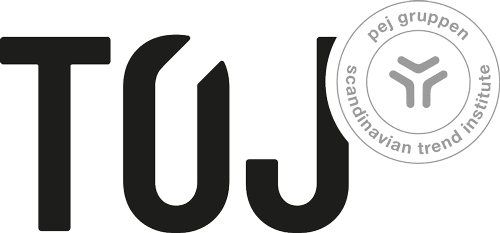The challenging corona years forced Danish companies to think anew and innovatively. But even though we have now passed the pandemic panic years, it might be time again to reinvent ourselves. It’s no secret that the fashion industry is currently going through turbulent years. Global crises, pressured market conditions, and general economic uncertainty have taken a toll on the past year’s financial statements and caused overall setbacks for an industry increasingly wrinkled with worry.
Therefore, many are trying to adjust to the global economic market conditions in all conceivable ways. According to Rasmus Thomsen, a long-time brand strategist, there is particularly one button that, for some companies, can show the way out of the breaking times and into increased market shares. The button is labeled ‘Rebranding,’ which is likely an unknown or diffuse concept for many. According to Rasmus Thomsen, who has helped several companies successfully rebrand their organizational identity, there is much to be gained by changing the target audience’s perception of the company’s brand.
“If you want to position yourself more strongly in the market, it’s definitely a good idea to scrutinize your company to determine whether there is a need to rebrand. If done correctly, it can boost sales, increase market shares, create a healthy corporate culture, foster more partnerships, and introduce new products,” he explains.
Crisis as a catalyst for change
Rasmus Thomsen knows what he’s talking about. For over 10 years, he has worked on branding strategies for Danish and international clients, including Ikea, Carlsberg, and Lufthansa. Today, he works as a freelance brand strategist, and when asked about the industry’s current challenges, he is quick to repeat the mantra that one should not let a good crisis go to waste.
“It’s always easier to be innovative when things are going well. We dare to innovate when there is surplus and room for failure, but actually, it’s in times of crisis that one should dare to think anew. Even if there is hardly any breathing room for it. Therefore, now is the right time to rebrand your company, provided the need is there,” he says, elaborating:
“There are many advantages to embarking on a rebranding process right now. First and foremost, it’s an active attempt to reverse a negative trend. It’s also an advantage in relation to competitors who are likely in survival mode rather than development mode. This means you can potentially come out very strong – especially when the market picks up again,” he explains, before flanking his advice with an important disclaimer.
According to Rasmus Thomsen, while there are undeniably several fashion companies that could and should rethink their brand, there are probably just as many for whom it would not make sense. Therefore, he emphasizes that one should not only understand the concept of rebranding but also understand the need – or lack thereof – before considering changing their brand.
Rebranding – but for whose sake?
Let’s rewind a bit. What exactly does the concept of rebranding entail – and what’s the difference between branding and rebranding? According to Rasmus Thomsen, rebranding occurs when a company attempts to influence and change the target audience’s perception of the company’s products, services, or brand. Unlike branding – a general strategic process that continuously ensures a positive brand for the company – rebranding is about repositioning and solving a specific problem.
The reasons for wanting to rebrand as a company can be many. It could be the desire to stand out from competitors in the market, to shed a poor image, to no longer be relevant to the target audience, or having new management wanting to chart a new direction. However, not all reasons justify reinventing the organizational identity, believes Rasmus Thomsen.
“The most important question to ask before a rebranding is whether the process is driven by internal or external logics. Does the market require us to do things differently, or do we just feel that something new needs to happen? Remember: ‘If it ain’t broke, don’t fix it.’ Many companies start rebranding on the wrong basis. They misunderstand the need. It could be that they want to reach an audience that is not actually their audience. Or they rebrand just to follow the trend and do ‘like the others,’ even though it doesn’t match their brand’s core story,” says Rasmus Thomsen, emphasizing:
“For God’s sake, don’t rebrand just because you’re bored or feel something new needs to happen. Rebranding depends 100% on a need in the market and among your target audience. I know it can be incredibly difficult to step aside and see yourself from the outside, but it is necessary.”
More than just a logo
The erroneous use of rebranding as a strategic makeover tool stem, among other things, from a pronounced misunderstanding of the very concept, which has caused some definitional confusion, explains Rasmus Thomsen.
“It’s important to stress that rebranding comes in different sizes. Typically, two overarching terms are used: ‘Full rebrand’ and ‘brand refresh.’ A full rebrand is the major strategic shift where you tear down the entire house and rebuild it, while a brand refresh is more about updating your identity, so it doesn’t look outdated. Calling a new logo or a new website a rebranding is therefore an exaggeration. A brand refresh can make a lot of sense, but it’s not rebranding. People see through that quickly. Branding must be broader and more comprehensive. I would argue that it’s not important for a design company to upgrade its logo unless it’s part of a larger strategy,” explains Rasmus Thomsen.
An ill-conceived or failed rebranding strategy is expensive and time-consuming. You also risk losing credibility or – in the worst case – losing your target audience, warns Rasmus Thomsen.
“It’s an opportune time for some design brands to consider rebranding, but you have to ask the right questions. The market has shrunk, so is that where the problem lies – or is there something within our own organization that is disorganized? Something unsustainable? Something inconsistent in our strategies and our identity? If the answer is yes, then rebranding is probably a solution,” he concludes.
8 good reasons to consider rebranding
- The company’s purpose, vision, or values have changed
- The company wants to launch a new core product that the brand cannot support
- The company wants to position itself significantly differently in the market
- The company wants to enter a new market that requires new consumption patterns
- The company intentionally wants to change both market and target audience
- The company is organizationally disorganized and has lost oversight
- The company has a bad image that it cannot shake off
- The company wants to merge brands, departments, or products
8 bad reasons to consider rebranding
- The company just wants to attract attention
- The company is bored and wants to create change
- The company’s need for rebranding is based on assumptions
- The company only wants to update individual elements, such as a logo
- New management wants to signal new directions and strategies
- The company wants to mimic its competitors
- The company wants to target an audience that does not match its core products
- The company thinks: “We can always go back to the old way”
How to get started with your rebranding
Rasmus Thomsen poses six questions that can kickstart your rebranding process:
Why are we doing this?
The reason and goal of your rebranding are the central starting points. Do you want to achieve a business goal, reach a new audience, or attract new talent? Or all three? Also, remember to ask yourself how many of your challenges are actually communication problems that can be solved with an increased focus on the brand.
What can only we do?
Any solid branding process starts with understanding your ‘thing’. What are you best at – or what makes you special? It doesn’t have to be a so-called ‘unique selling point’. It can also be a specific market opportunity or an ability to seize a trend. Ask yourself: What strengths and (hidden) potentials do we have that we can activate?
Do we understand the internal requirements?
The development process is always exciting, but the real work usually starts once the identity is in place. Do we understand how many hours it will take to implement the new brand? How do we get the organization on board? They are the ones who must carry the brand with pride. Also, remember to make things operational and real. What do we do differently on Monday?
Do we understand our surroundings?
It may seem like a cliché, but do you actually understand your surroundings – really? What does the market expect from us, and how can we positively surprise? What will our market and surroundings look like next year – and are there opportunities we haven’t seized? Hint: It’s not about becoming an expert in social media. On the contrary. It’s about empathy. Start by asking your current and former customers.
What is the ideal setup for us?
Make sure to choose the right setup for your organization. Will you outsource the entire process or be involved yourself? What are you equipped for? It could be an agency (large or small). An internal design team. Or a group of dedicated freelancers working with your team – perhaps directly at your office?
Rebrand or refresh?
Is there a need to reinvent the entire brand and its position, or is it enough to refresh specific and important channels, such as digital presence? Many brands were born at a time when channels and opportunities were different. Maybe it’s enough to optimize and prepare the brand for the new – and next – platforms?
Rebranding in the fashion industry
Many Danish fashion brands have undergone rebranding in recent years. Here are some examples:
Day Birger et Mikkelsen underwent a rebranding in 2021, where everything was rethought with creative director Christina Exsteen at the helm. It was especially about moving away from the bohemian style, which had previously been a success for the brand but had become passé in the fashion scene. Her task was to ensure that Day regained a place on the Danish fashion scene and create a new style.
Designers Remix has made a significant shift towards sustainability. The brand, which was previously known for using leather and fur, has since 2019 removed these materials from their collections and now focuses on recycled materials and redesign with surplus fabrics.
Birger Christensen, which has existed for over 150 years, has adapted by creating new sub-brands under Birger Christensen Collective. They launched the brand Rotate in 2019, which was created in collaboration with influencers and stylists Jeanette Madsen and Thora Valdimarsdottir.



